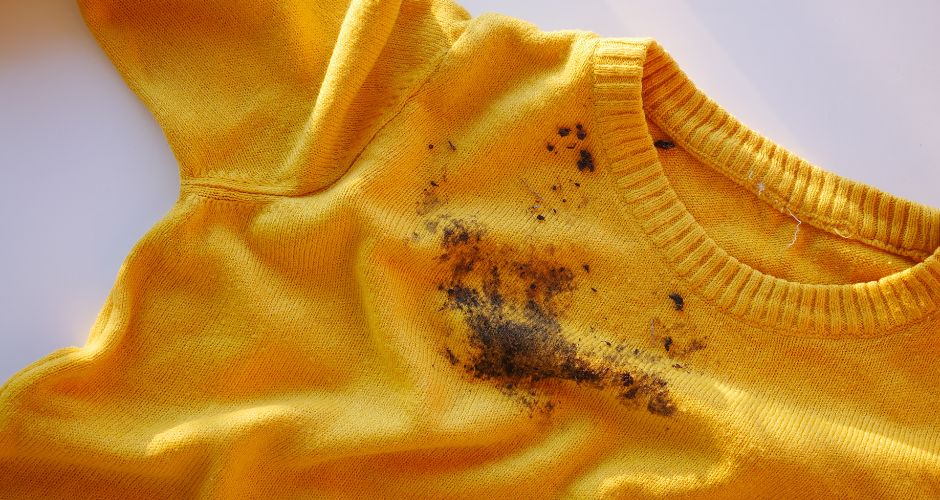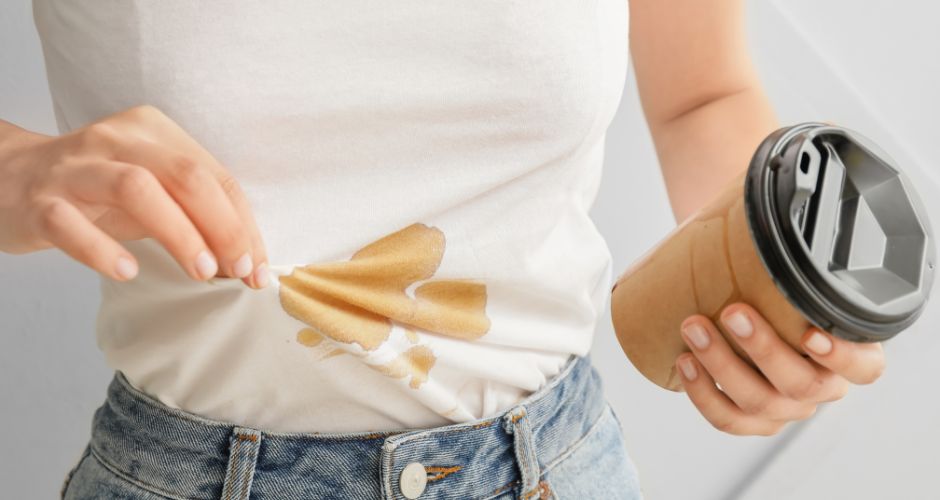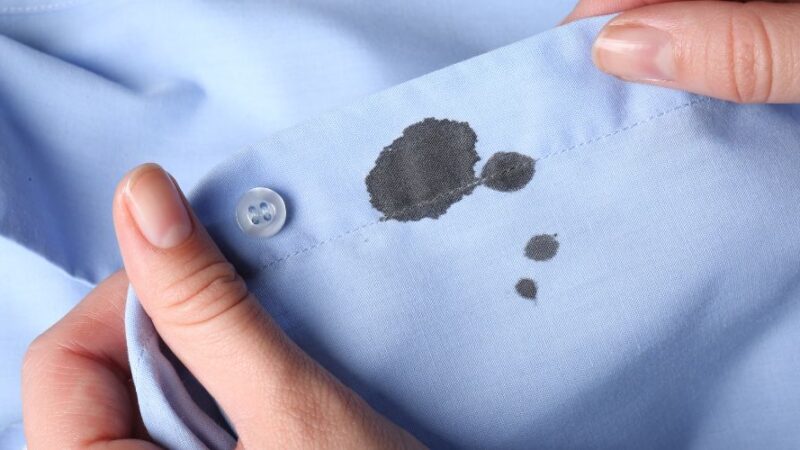13 Common Clothing Stains and How to Remove Them

Keeping clothes clean can feel like a never-ending challenge, especially when accidents happen. Whether it’s coffee in the morning, a splash of red wine at dinner, or your child’s marker streaks after school, stains can quickly ruin your favorite outfit.
But don’t worry – with the right techniques and a little know-how, most stains can be completely removed.
Here’s an in-depth guide to 13 of the most common clothing stains and exactly how to treat them, with tips, and examples.
1. Grease and Oil Stains
Examples: Cooking oil, butter, salad dressing, motor oil
How to Remove:
- Blot the stain with a paper towel to remove excess grease.
- Sprinkle baking soda or cornstarch directly onto the stain. Let it sit for 15-30 minutes to absorb the oil.
- Brush off the powder.
- Apply a few drops of dishwashing liquid (like Dawn) directly to the stain. Gently rub it in with a soft brush or your fingers.
- Let it sit for 10-15 minutes.
- Rinse with warm water, then launder as usual.
Tip: Don’t dry in the dryer until the stain is completely gone, as heat can set grease stains permanently.
Also check How to Remove Grease Stains from Clothes

2. Red Wine Stains
Examples: Wine spills during dinner or parties
How to Remove:
- Blot the stain with a clean cloth (do not rub!).
- Immediately sprinkle salt or baking soda on the stain to absorb the liquid.
- After a few minutes, rinse with cold water.
- Apply white vinegar followed by a small amount of liquid detergent.
- Soak in cold water for 30 minutes before washing.
Tip: Club soda is a great emergency solution if applied immediately.
3. Coffee and Tea Stains
Examples: Morning spills on shirts, tablecloths, or ties
How to Remove:
- Rinse the stain with cold water.
- Apply a mixture of equal parts white vinegar and water.
- Rub gently with your fingers.
- Add a small amount of laundry detergent and let sit for 5–10 minutes.
- Wash in the hottest water safe for the fabric.

FAQ: What if the coffee had milk or sugar? Treat it as both a protein and sugar stain – rinse with cold water and apply an enzyme-based detergent.
4. Blood Stains
Examples: Cuts, nosebleeds, scraped knees
How to Remove:
- Use cold water – never hot.
- Rinse the fabric under cold running water.
- Soak in cold water with a bit of salt or hydrogen peroxide (check colorfastness first).
- Use an enzyme detergent or stain remover, let it sit for 30 minutes.
- Wash as usual.
Tip: Older stains might require multiple treatments or soaking overnight.
5. Grass Stains
Examples: Kids playing outside, gardening clothes
How to Remove:
- Pre-treat with a stain remover or rubbing alcohol.
- Let it sit for 15 minutes.
- Gently scrub with a toothbrush.
- Apply liquid laundry detergent and rub into the stain.
- Launder in warm water.
Tip: For whites, use hydrogen peroxide or a bleach safe for the fabric.
6. Ink Stains
Examples: Leaking pens, art projects, office mishaps
How to Remove:
- Place a paper towel under the stained area.
- Dab rubbing alcohol or hand sanitizer onto the stain using a cotton ball.
- Blot (don’t rub!) until the ink starts to lift.
- Rinse with cold water.
- Wash normally.
7. Sweat Stains
Examples: Underarm yellowing on white shirts
How to Remove:
- Mix baking soda, hydrogen peroxide, and water into a paste.
- Apply to the stained area.
- Let it sit for 30–60 minutes.
- Scrub gently with a toothbrush.
- Wash in warm water.
Tip: Avoid bleach on sweat stains as it can make them worse.
Check out How to Remove Sweat Stains from White Shirts
8. Chocolate Stains
Examples: Melty desserts, chocolate bars in pockets
How to Remove:
- Scrape off excess chocolate with a spoon.
- Rinse the back of the stain with cold water.
- Rub liquid laundry detergent into the stain.
- Soak in cold water for 15–30 minutes.
- Wash in warm water.
Tip: Repeat if necessary, especially for darker chocolate.

9. Tomato Sauce Stains
Examples: Pasta spills, ketchup, pizza sauce
How to Remove:
- Scrape off the excess sauce gently.
- Rinse under cold water from the back.
- Apply liquid detergent and let sit.
- Rub gently with fingers or a soft brush.
- Wash in the warmest water safe for the fabric.
Want to know Why Is My Floor Sticky After Mopping?
10. Makeup Stains
Examples: Foundation on collars, lipstick on shirts
How to Remove:
- For foundation: Use shaving cream or dish soap directly on the stain.
- For lipstick: Dab with rubbing alcohol or makeup remover.
- Gently blot and rinse.
- Wash as usual.
Tip: Baby wipes work great for fresh makeup stains on the go.
Learn 11 Cleaning Myths You Need to Avoid
11. Paint Stains
Examples: Acrylic paint from crafts, house paint, wall touch-ups
How to Remove:
- Water-based paint (like acrylic or latex): Rinse the stain under warm water while it’s still wet. Apply dish soap and rub gently with your fingers or a brush. Launder as usual.
- Oil-based paint: Blot with a cloth dampened with turpentine or paint thinner (test a hidden spot first). Rinse thoroughly. Follow up with dish soap and warm water, then wash.
Tip: Act fast! Once paint dries, removal becomes much harder, and sometimes impossible.
12. Deodorant Stains
Examples: White marks or stiff patches on underarms of shirts
How to Remove:
- Mix baking soda with a little water to form a paste.
- Apply to the stained area and scrub gently with a toothbrush.
- Let it sit for 30 minutes.
- Rinse and launder normally.
Tip: Try lemon juice on white fabrics to brighten and break down buildup.
13. Mustard Stains
Examples: Hot dog or sandwich spills
How to Remove:
- Scrape off excess mustard with a dull knife or spoon.
- Rinse the stain under cold running water.
- Pre-treat with a stain remover or liquid laundry detergent.
- Let it sit for at least 10–15 minutes.
- Launder in warm water.
Tip: Mustard contains turmeric, which can be stubborn. Repeat treatment if needed.
Also check How to Get Oil Stains Out of Clothes
Final FAQs:
Q1: Should I dry stained clothes before the stain is gone?
A: No. Heat from the dryer can permanently set the stain. Always air-dry until you’re sure the stain is fully removed.
Q2: Can I use bleach on all stains?
A: No. Bleach is only safe for certain white fabrics. On colored fabrics, it can cause discoloration.
Q3: Are commercial stain removers better than home remedies?
A:They’re often faster and more convenient, but home remedies can be just as effective and more affordable.
Q4: What is the most common stain on clothes?
A: The most common stain on clothes is food-related stains, especially from items like tomato sauce, coffee, oil, and wine. These often happen during daily meals and can be tricky if not treated quickly.
Q5: What is most commonly used for stain removing?
A: White vinegar, baking soda, hydrogen peroxide, dish soap, and commercial stain removers are the most commonly used stain-removal agents. Their effectiveness depends on the type of stain and fabric.
Q6: What is the best way to remove stains from clothes?
A: The best way is to treat the stain as soon as possible. Blot (don’t rub), rinse with cold water, apply a stain remover or DIY solution (like baking soda + vinegar), and wash according to the garment’s care label. For stubborn stains, soaking the fabric before washing can help.
Q7: What is the most common type of stain?
A: Protein stains (like sweat, blood, dairy) and grease/oil stains are the most common types. They often occur in everyday life and require specific treatments—protein stains respond well to cold water, while grease needs dish soap or an enzyme cleaner.
Q8: How do I remove tough stains from clothes at home?
A: To remove tough stains, act quickly by blotting the area to absorb excess liquid. Pre-treat the stain with a stain remover or a DIY solution (such as baking soda or vinegar), then wash in the appropriate water temperature. For stubborn stains, soak the fabric before washing and repeat if necessary.
Q9: Can I remove stains from colored clothes at home?
A: Yes! To remove stains from colored clothes, use a color-safe stain remover or natural solutions like baking soda and vinegar. Wash the garment in cold water with a mild detergent to protect the fabric’s color. Avoid using regular bleach, as it can fade the colors.
Q10: How do I remove black stains from colored clothes?
A: Black stains, often caused by ink or dye, can be tricky. Start by blotting the stain gently, then apply rubbing alcohol or a dish soap and baking soda solution for oil-based stains. Wash the garment in cold water to prevent any further damage to the color.
Q11: Should I wash clothes immediately after treating a stain?
A: Yes! It’s important to wash the fabric as soon as possible after treating the stain. However, for particularly stubborn stains, you may need to repeat the process before washing. Always check the garment to ensure the stain is gone before drying it.
Q12: Can I use vinegar and baking soda to remove stains from clothes?
A: Yes, vinegar and baking soda are effective for many types of stains. They work well on food stains, sweat marks, and even mildew. Always test on a small, hidden area first to ensure no damage occurs to the fabric.
Q13: Will hot water remove stains from clothes?
A: Hot water can help remove some stains, especially grease and oil, but cold water is recommended for stains like blood, sweat, or ink to avoid setting the stain into the fabric. Always check the care label for the best washing instructions.





